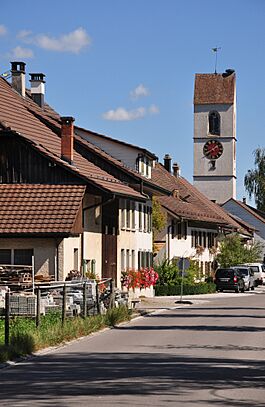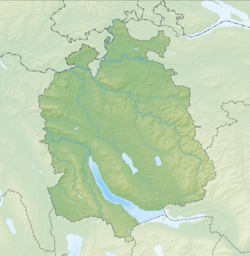Wiesendangen facts for kids
Quick facts for kids
Wiesendangen
|
||
|---|---|---|
 |
||
|
||
| Country | Switzerland | |
| Canton | Zürich | |
| District | Winterthur | |
| Area | ||
| • Total | 19.17 km2 (7.40 sq mi) | |
| Elevation | 469 m (1,539 ft) | |
| Population
(Dec 2020 )
|
||
| • Total | 6,633 | |
| • Density | 346.01/km2 (896.16/sq mi) | |
| Postal code |
8542
|
|
| Localities | Wiesendangen, Attikon, Wallikon, Buch, Menzengrüt | |
| Surrounded by | Ellikon an der Thur, Elsau, Hettlingen, Rickenbach, Winterthur | |
Wiesendangen is a town, also called a municipality, located in the Winterthur area. It is part of the canton of Zürich in Switzerland.
On January 1, 2014, another town called Bertschikon joined with Wiesendangen. This made Wiesendangen bigger.
Contents
A Look at Wiesendangen's Past
Wiesendangen and its nearby areas have a long history. Today's Wiesendangen includes many smaller places. These are Wiesendangen, Attikon, Wallikon, Menzengrüt, Buch, Bertschikon, Gundetswil, Kefikon, Liebensberg, Stegen, Gündlikon, and Zünikon.
Ancient Times and Early Settlements
People lived here a very long time ago. In the 2nd and 3rd centuries, the Romans built homes and farms here. These were along a road that connected two Roman settlements.
The area became part of St. Gallen Abbey, a famous monastery, in the year 804. This is when Wiesendangen was first written about. It was called Wisuntwangas, which means "wisent pasture." A wisent is a type of European bison.
Another village, Bertschikon, was first mentioned in records in 1255. Gündlikon might have been mentioned as early as 774, but we know for sure it was mentioned in 1162.
Medieval History and Local Rulers
In the early 1100s, a tower house was built here. Important people called ministeriales lived in it. They worked for the House of Kyburg, a powerful family. These people were sometimes called von Wiesendangen or von Frauenfeld. They were like local managers or reeves in Frauenfeld.
The land was given to the Hohenlandenberg family in 1472 by the bishop of Constance. Over time, control of the area shifted. By 1452, the important legal power (called High justice) went to Zürich. Later, in 1587, the local legal power (called low justice) also became part of Zürich.
Modern Wiesendangen Takes Shape
The municipality of Wiesendangen was officially created in 1798. Its borders followed older church areas. The municipality of Bertschikon was also created in 1798. In 1881, Bertschikon joined with several other small villages.
In 1928, Attikon, Wallikon, Menzengrüt, and Buch became part of Wiesendangen. This made Wiesendangen even larger.
A train station was built near Attikon in 1855. It was moved into Attikon in 1907. After 1945, Wiesendangen changed from a group of small farming villages. It grew into a part of the bigger city area around Winterthur. The A1 motorway, a major highway, was built in the 1970s. It runs between Attikon and Bertschikon.
Wiesendangen's Landscape
Before the towns merged, Wiesendangen covered about 9.5 square kilometers (3.7 square miles). A large part of this land, about 54.7%, is used for farming. Forests cover about 25.4% of the area.
About 19.8% of the land has buildings or roads on it. A very small part, 0.1%, is made up of rivers or other natural areas. In 1996, homes and other buildings took up 11% of the land. Roads and other transport areas made up 8.7%.
After the merger, the total area of Wiesendangen became much larger.
People of Wiesendangen
Before the merger, in 2012, about 4,927 people lived in Wiesendangen. After Bertschikon joined, the population grew to 5,977 people by December 2011.
Population Details
In 2007, about 6.9% of the people living in Wiesendangen were from other countries. In 2008, about 49.1% of the people were male and 50.9% were female. Over the last 10 years, the number of people living here has grown by 19%.
Most people in Wiesendangen (95.3%) speak German. French is the second most common language (1.1%), and Italian is third (1.0%).
Education and Work
Many adults in Wiesendangen are well-educated. About 86.6% of people aged 25 to 64 have finished high school or gone on to higher education. This includes university or a Fachhochschule (a type of professional university). There are 1,634 homes in Wiesendangen.
Wiesendangen has a low unemployment rate of 1.25%. This means most people who want to work have jobs.
The jobs in Wiesendangen are divided into three main types:
- Primary sector: This includes jobs like farming. In 2005, 114 people worked in this area.
- Secondary sector: This includes jobs in manufacturing and building. There were 159 people working here.
- Tertiary sector: This includes jobs in services, like shops, offices, and healthcare. 419 people worked in this sector.
In 2007, about 32.2% of working people had full-time jobs. The other 67.8% worked part-time.
Religious Beliefs
In 2008, there were 1,117 Catholics and 2,563 Protestants in Wiesendangen.
In the 2000 census, 65.3% of people were Protestant. Most of these (62%) belonged to the Swiss Reformed Church. About 23.4% of the people were Catholic. A small number of people belonged to other religions, or did not state a religion. About 8% said they were atheist or agnostic.
Transportation in Wiesendangen
The Wiesendangen railway station is an important stop for local trains. It is part of the Zurich S-Bahn system. You can catch trains on lines S24 and S30 from this station.
Images for kids
See also
 In Spanish: Wiesendangen para niños
In Spanish: Wiesendangen para niños





